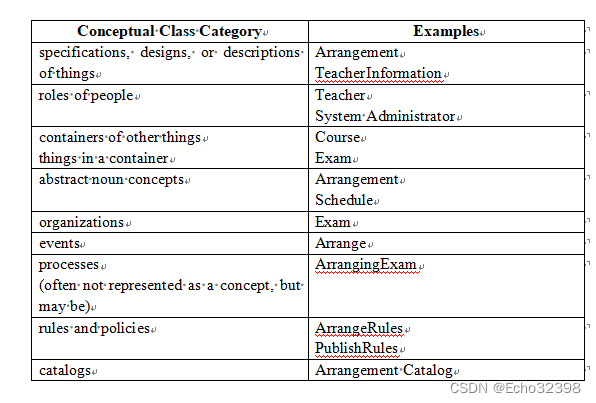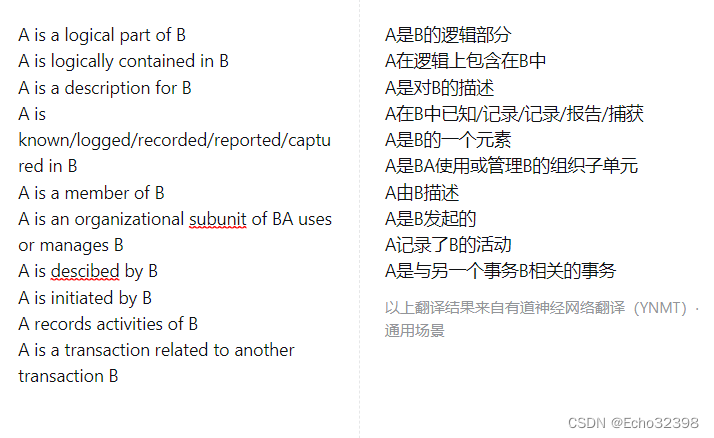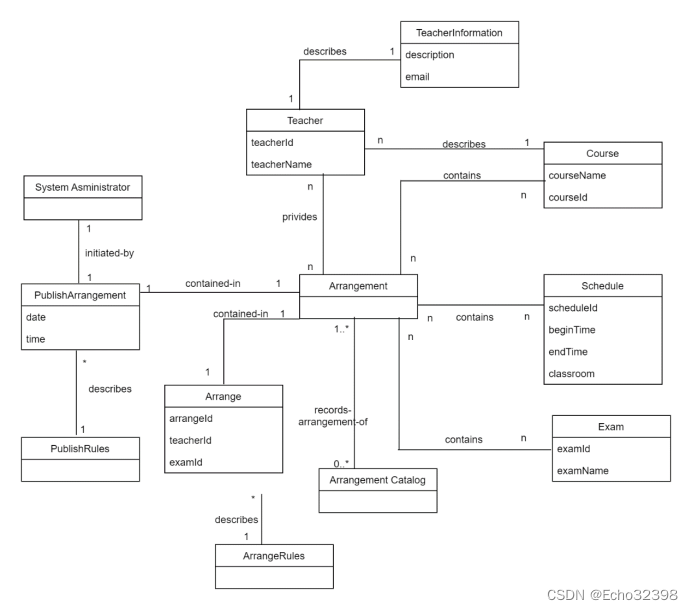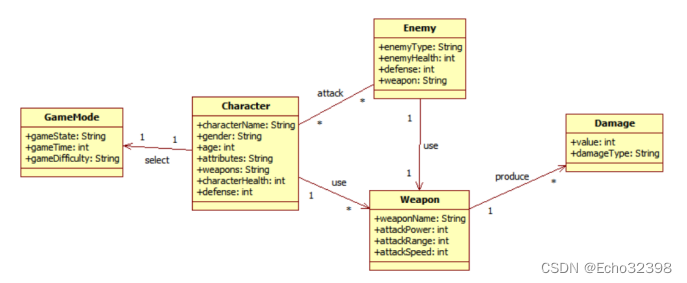习题
问题
考察点
领域建模
识别概念类
固定模板
Conceptual Class Category
Examples
specifications,designs, or descriptions of things
roles of people
containers of other things
things in a container
abstract noun concepts
organizations
events
processes
(often not represented as a concept, but may be)
rules and policies
catalogs
模板解析
| Conceptual Class Category | Examples | |
| specifications,designs, or descriptions of things | 规格、设计或对事物的描述 | 用例中的信息 Information( Arrangement TeacherInformation ) |
| roles of people | 角色(人物) | 用户、 System Administrator...( Teacher System Administrator ) |
| containers of other things things in a container | 容器 容器里的东西 | (Course、Exam)书架和书的关系 |
| abstract noun concepts | 抽象名词概念 | (Arrangement、Schedule)状态、许可、窗口等 |
| organizations | 组织 | 哪里需要用到(Exam) |
| events | 事件 | 发生了什么事(Arrange、Return)填写动词 |
| processes (often not represented as a concept, but may be) | 流程 (通常不表示为概念,但可能是) | 干了什么,通常是方法(ArrangingExam、ReturnBook)动宾短语 |
| rules and policies | 规则和政策 | 有什么规则 (ArrangeRules PublishRules)就是上面动作+规则rules |
| catalogs | 分类 | 哪些分类(Arrangement Catalog)你这个用例中的主体+catalog |
在领域模型中的"Conceptual Class Category"部分,您应根据概念类的特性将其归类到上述提供的类别之一。下面是每个类别简要说明及填充示例:
Specifications, Designs, or Descriptions of Things:
- 包含对事物特性的定义或描述。例如,在设计一个图书管理系统时,“BookSpecification”可以是一个概念类,用来描述书籍的规格或标准。
Roles of People:
- 表示人(用户、参与者)在系统或业务流程中扮演的角色。例如,“Customer”,“Librarian”。
Containers of Other Things:
- 代表能够包含其他对象的实体。例如,“ShoppingCart”可以是一个容器类,里面包含了多个“CartItem”。
Things in a Container:
- 容器内的具体项目。如前例中的“CartItem”。
Abstract Noun Concepts:
- 抽象概念,通常不直接映射为物理对象,但对理解领域至关重要。比如,“Membership”表示会员资格。
Organizations:
- 组织结构或实体。例如,“School”,“Department”。
Events:
- 发生在系统中或由系统触发的重要状态改变。例如,“OrderPlaced”,“PaymentProcessed”。
Processes (often not represented as a concept, but may be):
- 业务流程或操作序列,虽然通常不直接作为概念类,但在某些情况下可能需要抽象为类来管理其状态或规则,如“OrderProcessingWorkflow”。
Rules and Policies:
- 系统或业务遵循的规定或策略。例如,“ShippingPolicy”,定义了货物运送的规则。
Catalogs:
- 集合或分类信息的列表。例如,“ProductCatalog”列出了所有可销售的产品。
在填写时,您应分析并确定每个概念类最适合的类别,以便更清晰地组织和表达领域模型的结构。
示例

| Conceptual Class Category | Examples |
| specifications, designs, or descriptions of things | Weapon, Damage, GameMode |
| roles of people | Character, Enemy |
为概念类添加联系
| Category(根据实际需要选择) | Examples(当中涉及到的概念为上述表格中所提到的,不一定都是依据具体情况而言) |
| A is a logical part of B | BlogState -> Blog |
| A is logically contained in B | Image,Video -> BlogText Title、Author、Date -> Blog |
| A is a description for B | ReviewDescription -> Review PublishDescription -> Publish |
| A is known/logged/recorded/ reported/captured in B | Blog -> BlogCatalogs Input window -> Blog Input window -> BlogText |
| A is a member of B | Blog -> BlogCatalogs |
| A is an organizational subunit of B A uses or manages B | BlogText -> Blog BlogState -> Blog Administrator -> Review Blog -> Publish Student->AcademicSystem; |
| A is descibed by B | UserSpecification -> SystemAdministrator Review -> ReviewRules Publish -> PublishRules Blog -> BlogDecription Blogger -> UserSpecrification |
| A is initiated by B | Blog -> Blogger |
| A records activities of B | Blog -> BlogCatalog |
| A is a transaction related to another transaction B | Arrangement -> Schedule |

在领域模型中为概念类添加联系时,您需要明确描述不同概念类之间的关系本质。根据您提供的联系类型提示,这里是如何填写或描述这些联系的一些建议:
A is a logical part of B
- 描述:表示A是B的一个组成部分,A的存在依赖于B,且A不能脱离B而独立存在。
- 填写示例:“引擎(Engine)是汽车(Car)的一个逻辑组成部分。”
A is logically contained in B
- 描述:意味着A作为实体被B所包含,但A相对独立,可能有自己独立的生命周期。
- 填写示例:“章节(Chapter)逻辑上包含于书籍(Book)中。”
A is a description for B
- 描述:表示A是用来描述B特征或属性的类。
- 填写示例:“产品规格(ProductSpecification)是对产品的描述。”
A is known/logged/recorded/reported/captured in B
- 描述:说明B记录或保存了关于A的信息。
- 填写示例:“交易记录(TransactionRecord)记录了购买行为(Purchase)的细节。”
A is a member of B
- 描述:表明A属于B的集合或群体中的一员。
- 填写示例:“员工(Employee)是公司(Company)的成员。”
A is an organizational subunit of B
- 描述:指出A是B在组织结构中的下级单位。
- 填写示例:“市场部门(MarketingDepartment)是公司(Company)的组织子单元。”
A uses or manages B
- 描述:说明A使用或负责管理B。
- 填写示例:“系统管理员(SystemAdmin)管理着服务器资源(ServerResource)。”
A is described by B
- 描述:类似于“A is a description for B”,但强调B描述了A。
- 填写示例:“用户评价(UserReview)描述了商品(Product)的质量。”
A is initiated by B
- 描述:表示B触发或启动了A的动作或过程。
- 填写示例:“订单处理(OrderProcessing)由客户下单(CustomerOrderPlacement)发起。”
A records activities of B
- 描述:说明A记录或跟踪B的活动。
- 填写示例:“日志文件(LogFile)记录了系统操作(SystemOperation)的活动。”
A is a transaction related to another transaction B
- 描述:表示A和B是相关的交易或事件,可能在业务流程中有依赖或关联。
- 填写示例:“退款(RefundTransaction)与原始购买(OriginalPurchaseTransaction)相关联。”
通过这种方式填写,您可以清晰地表达出领域模型中概念类之间的逻辑关系和交互方式。
示例
| Category | Examples |
| A is a description for B | TecherInformation->Teacher Schedule->Arrangement Exam->Arrangement |
| A is known/logged/recorded/ reported/captured in B | Arrangement -> Arrangement Catalog |
| A is a member of B | Course Information -> Exam Arrangement Information -> System Arrangement -> Arrangement Catalog |
| A is rules or policies of B | PublishRules -> Publish ArrangeRules-> Arrange |
| A is an organizational subunit of B A uses or manages B | Teacher -> Arrangement Teacher -> Course System Administrator -> Arrangement |
| A is a transaction related to another transaction B | Arrangement -> Schedule |
| Category | Examples |
| A is logically contained in B | Weapon--Character Weapon--Enemy Damage--Weapon |
| A is a description for B | Activity Description -> Activity |
| A is a member of B | Weapon--Character Weapon--Enemy |
| A uses or manages B | Character--Weapon Enemy--Weapon |
添加概念类属性并画出领域模型图
识别概念类中的概念为一个独立的节点,为概念类添加联系中的关系描述词作为链路,画出领域建模图
示例 (注意需要标明是1对多,还是多对1)
问题:
- 联系需要方向
- 属性需要类型
process不用画


我的答案
不一定对,绞尽脑汁想出来的
1.识别概念类
概念类是一种名词,识别概念类的策略:
2 为概念类添加联系
Conceptual Class Category
Examples
specifications, designs, or descriptions of things
BookSpecification
roles of people
Reader
containers of other things
things in a container
Bookshelf
BorrowRecordsCollection
Book
BorrowRecord
abstract noun concepts
BorrowStatus
events
Borrow
Return
processes
(often not represented as a concept, but may be)
BorrowBook
ReturnBook
rules and policies
BorrowRules
ReturnRules
catalogs
BookCatalog
Category
Examples
A is a description for B
BookSpecification ->Book
BorrowStatus->BorrowRecord
A is known/logged/recorded/
reported/captured in B
Book->BookCatalog
BorrowRecord->BorrowRecordsCollection
A is a member of B
Book->BookCatalog
A is rules or policies of B
BorrowRules->Borrow
ReturnRules->Return
A uses or manages B
Reader->Borrow
Reader->Return
A is located/placed on/in B
Book->Bookshelf
A is initiated by B
Borrow->Reader
Return->Reader
A is performed on B
Borrow->Book
Return->Book
A records the occurrence of B
BorrowRecord->Borrow
3 添加概念类属性并画出领域模型图

























 450
450

 被折叠的 条评论
为什么被折叠?
被折叠的 条评论
为什么被折叠?








